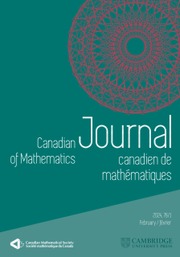Crossref Citations
This article has been cited by the following publications. This list is generated based on data provided by Crossref.
PAPAPETROU, A.
and
SCHRÖDINGER, E.
1951.
The Point-Charge in the Non-symmetric Field Theory.
Nature,
Vol. 168,
Issue. 4262,
p.
40.
Vaidya, P. C.
1953.
Spherically Symmetric Solutions in Nonsymmetrical Field Theories. I. The Skew Symmetric Tensor.
Physical Review,
Vol. 90,
Issue. 4,
p.
695.
Kilmister, C. W.
and
Stephenson, G.
1954.
An axiomatic criticism of unified field theories—I.
Il Nuovo Cimento,
Vol. 11,
Issue. S1,
p.
91.
Mavrides, Stamatia
1955.
Choix de la métrique et du champ électromagnétique en théorie unitaire d'Einstein. Lien avec la théorie de Born-Infeld.
Journal de Physique et le Radium,
Vol. 16,
Issue. 6,
p.
482.
Buchdahl, H. A.
1957.
Reciprocal static solutions of field equations involving an asymmetrical fundamental tensor.
Il Nuovo Cimento,
Vol. 5,
Issue. 5,
p.
1083.
Wyman, Max
and
Zassenhaus, Hans
1958.
Zero Curvature Tensor in Einstein's Unified Field Theory.
Physical Review,
Vol. 110,
Issue. 1,
p.
228.
Pachner, Jaroslav
1959.
Die unitäre Feldtheorie der Schwere und Elektrizität.
Annalen der Physik,
Vol. 460,
Issue. 1-2,
p.
70.
Papapetrou, A.
and
Treder, H.
1959.
Zur Frage der Existenz von singularitätsfreien Lösungen der allgemein‐relativistischen Feldgleichungen, die Teilchenmodelle darstellen könnten.
Annalen der Physik,
Vol. 458,
Issue. 7-8,
p.
360.
Israel, W.
and
Trollope, R.
1961.
New Possibilities for a Unified Field Theory.
Journal of Mathematical Physics,
Vol. 2,
Issue. 6,
p.
777.
Vanstone, J. R.
1962.
The General Static Spherically Symmetric Solution of the "Weak" Unified Field Equations.
Canadian Journal of Mathematics,
Vol. 14,
Issue. ,
p.
568.
1971.
Bulletin GRG, No. 26: List of publications.
General Relativity and Gravitation,
Vol. 2,
Issue. 2,
p.
185.
Johnson, Coates R.
1971.
Motion of Particles in Einstein's Relativistic Field Theory. II. Application of General Theory.
Physical Review D,
Vol. 4,
Issue. 2,
p.
318.
Tiwari, R
and
Pant, D N
1972.
Nonexistence of isolated charged monopoles in unified field theories.
Journal of Physics A: General Physics,
Vol. 5,
Issue. 3,
p.
394.
Pant, D. N.
1975.
Spherically symmetric rigorous solutions in Bonnor’s unified field theory.
Il Nuovo Cimento B Series 11,
Vol. 25,
Issue. 1,
p.
175.
Boal, D. H.
and
Moffat, J. W.
1975.
Physical consequences of a solution of the nonsymmetric unified field theory.
Physical Review D,
Vol. 11,
Issue. 8,
p.
2026.
Moffat, J. W.
and
Boal, D. H.
1975.
Solutions of the nonsymmetric unified field theory.
Physical Review D,
Vol. 11,
Issue. 6,
p.
1375.
Johnson, Coates R.
and
Nance, Jon R.
1977.
Charged particles in Einstein's unified field theory.
Physical Review D,
Vol. 15,
Issue. 2,
p.
377.
Huerta, Robert
and
Parker, Barry
1979.
Particle solutions in a unified field theory.
Physical Review D,
Vol. 19,
Issue. 10,
p.
2853.
Moffat, J. W.
1979.
New theory of gravitation.
Physical Review D,
Vol. 19,
Issue. 12,
p.
3554.
Treder, H.‐J.
1980.
Einsteins hermitesche Relativitätstheorie als Unifikation von Gravo‐ und Chromodynamik.
Annalen der Physik,
Vol. 492,
Issue. 4,
p.
250.





